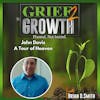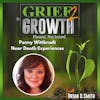🔒 Exploring Connections Beyond Death: The Continuing Bonds Model

Subscribe
Have you been told grieving the loss of a loved one meant severing ties with them, letting go, and moving on? Religion tells us this- maybe we'll see them later. Materialism tells us they're gone for good.
What if I told you there's another way? In this heartfelt episode, I share my journey with grief and how it led me to discover the Continuing Bonds Model. This approach says our connections with loved ones don't have to end when they pass on. It's been a transformative journey for me, particularly after my daughter Shayna's passing, and I hope sharing it brings comfort and hope to those grappling with their grief.
As we explore the traditional Freudian view of grief and how it contrasts with the Continuing Bonds Model, I share my experiences and learnings about how I've been able to include Shayna in my daily life, communicate with her, and carry her legacy forward. This isn't about rushing through life to 'get to the good stuff'; it's about embracing the present and understanding that our loved ones are still part of our lives, even if in a different way. Whether you're dealing with loss or just curious about alternate approaches to grief and mourning, this episode offers a compassionate, integrative perspective that challenges conventional wisdom.
Discover a unique online space dedicated to individuals navigating the complexities of grief. Our community offers a peaceful, supportive environment free from the distractions and negativity often found on places like Facebook. Connect with others who understand your journey and find solace in shared experiences.
https://grief2growth.com/community
🧑🏿🤝🧑🏻 Join Facebook Group- Get Support and Education
👛 Subscribe to Grief 2 Growth Premium (bonus episodes)
📰 Get A Free Gift
📅 Book A Complimentary Discovery Call
📈 Leave A Review
Thanks so much for your support
Hey there, welcome back to another special episode of Grief to Growth. Just for my cherished patrons and supporters. I appreciate you very much. Your financial support means a lot to me. Also, I appreciate you sharing the podcast whenever you can with whomever you can, so we can reach as many people as possible. But your financial support helps me to keep doing this and I want to say thank you again.
Speaker 1:
I want to talk today about something called Continuing Bonds, and since you're listening to this and I'm assuming it's not the first time you've listened to me, since you're supporting the show you're probably aware of the Continuing Bonds model, but maybe not by its name. And the Continuing Bonds model of grief basically says that when our loved ones pass on from this life, that we continue the bond with them. But it hasn't always been this way, and even for someone who was raised with the religious background, like I was, we were taught to think of the afterlife as the sweet by and by. In the distance, in the future, we would see our loved ones. In fact, many of us were taught that our loved ones slept after they had passed, that they literally slept in their graves until Jesus came back and Resurrection Day came. So this model says that our loved ones are no longer with us. So I moved on from that model. I thought of our loved ones as being in heaven, but still, even being in heaven, we don't have access to them. They're not part of our daily lives.
Speaker 1:
So when Shayna passed away in 2015 at the age of 15 years, what I found myself doing was I was stuck in the past. I could only cling to those 15 years that we had together, and I'm a very visual person, so I kind of saw my life as up into that point when Shayna passed, and then just abruptly ending and it's really all I could think about at first after Shayna passed. And then eventually I moved on to the point where I could think about the future, when I would see Shayna again, and this was somewhat helpful. But then this made me want to rush through my life to get to the end, to when I could see her again, to get to the good stuff, and it left this huge gap that might be years or decades between the time that I had joy when Shayna was here and the time that I would see her again. So this is where I was until I started. I became part of Helping Parents Heal, and I learned about this model of continuing bonds that our loved ones are actually still with us and still active parts of our lives as we're continuing our journey.
Speaker 1:
And I remember specifically hearing the phrase moving on. In fact, I was talking to someone I won't say her name, but she was writing a book and she asked me about her book and I think I was looking at it and she used the phrase moving on and I thought I hate that. I didn't know why I hated it, but the phrase moving on felt like a betrayal to me. It felt like again I was leaving Shayna there in the past and I was moving on without her. I really like the phrase moving forward better. Looking moving forward means that I'm moving forward with her.
Speaker 1:
Now, this earlier model of grief I talked about even if you think about, your loved ones are still on the other side waiting for you. It's kind of based on Freud's work, and Freud's grief work model says that the goal of mourning is to sever our ties. The goal of mourning is to let go, it's to move on, and Freud believed that this was a necessary thing to mend this gaping wound that was left by loss and to return to a sense of normalcy. The only way to do that was to move on, and people, even today, even though continuing bonds has become more popular since the 1990s, still traditionally grief counseling. It's kind of like the love one is almost seen as an addiction and you're addicted to a substance or to something, someone who is no longer available. So it makes sense to move on to, to let that person go. But what we realize is people don't work that way. We don't want to let go of our loved ones. It's not, it's not healthy, it's not necessary and in fact it's not true.
Speaker 1:
I'm a big believer in the team concept and if you heard me for any amount of time, you probably heard me mention the team books, which says that our loved ones that are even walking the earth with us, and our loved ones in spirit, they are always with us, they're continually present with us. We are, we are never alone, including our loved ones who have walked the earth with us and who have passed on before us. So I, this model, gave me back not only my future, it gave me back my present. It gave me back my now. It gave me a sense of what should I do now. How do I continue Shayna's legacy? How do I talk to Shayna? How do I communicate with Shayna? How do I include her in my life as I move forward? So it's it's like it's like bonus.
Speaker 1:
You know, paul talks in the Bible about how you know if, if he dies, he's present with the Lord. But right now he's present with the Lord. So it's kind of a no lose situation. And it's the same thing with our loved ones who have passed on. When I pass on, I will see Shayna again in a more direct way, but while I'm still here I can still have that, that that relationship or that that um, moving forward with her, and she's still a very much a part of my life.
Speaker 1:
So this is a very, very important thing that I teach when I'm working with people in grief.
Speaker 1:
It is to me it's the key to every get everything to, to integrate that new relationship, to understand how do I pursue this continuing bonds, how do I learn to communicate with my loved one, how do I learn to feel their presence, how do I make this a real part of my day to day existence?
Speaker 1:
And by doing so it makes the grief we go through a little bit more bearable. Now I do want to say that it doesn't eliminate grief. It doesn't say that we don't long for our loved ones in the physical, because we are so used to the physical and the physical is so present to us that we really have to work to keep this model foremost in our mind. And sometimes we fall down, sometimes we fall short, but it's a goal and it's a great way of viewing our lives after a tragic loss. So that's all I have for you for today. Let me know what you think about continuing bonds, if you've heard about before how it is real in your life, how you can make it more real in your life, and if you have any questions for me, anything you'd like for me to address on future episodes, let me know that as well. I'm always looking for great questions to address on future episodes. So with that I will sign off and say have a great day.












